Marketplace Seller Management: How to Balance Sellers and Buyers in an eCommerce Marketplace Using LTV
However, the supply-demand balance that was built once successfully never stays steady but is rather an ongoing challenge.
Chaotically growing supply and demand sides constantly cause disappointed buyers if demand outpaces supply and idle sellers in the opposite case.
This spoils the traction which was gained once and decreases sales even for a well-established online multi-store marketplace.
By using your customer lifetime value, you know exactly when, how and at which speed you should grow your buyer and seller numbers, to enable stable and balanced supply-demand growth on a long term.
1. How Customer Lifetime Value is improving supply-demand balance
Customer lifetime value (CLV) forecasts the total economic value that a customer brings to an eCommerce multi-seller mall from the first transaction to the final purchase.
There are few components that should be measured in order to build a picture of a multi vendor ecommerce store CLV: customer’s net profit, average order value, transaction frequency, customer total lifetime duration as a client of a virtual mall website, and user acquisition costs.
Customer Lifetime Value components:
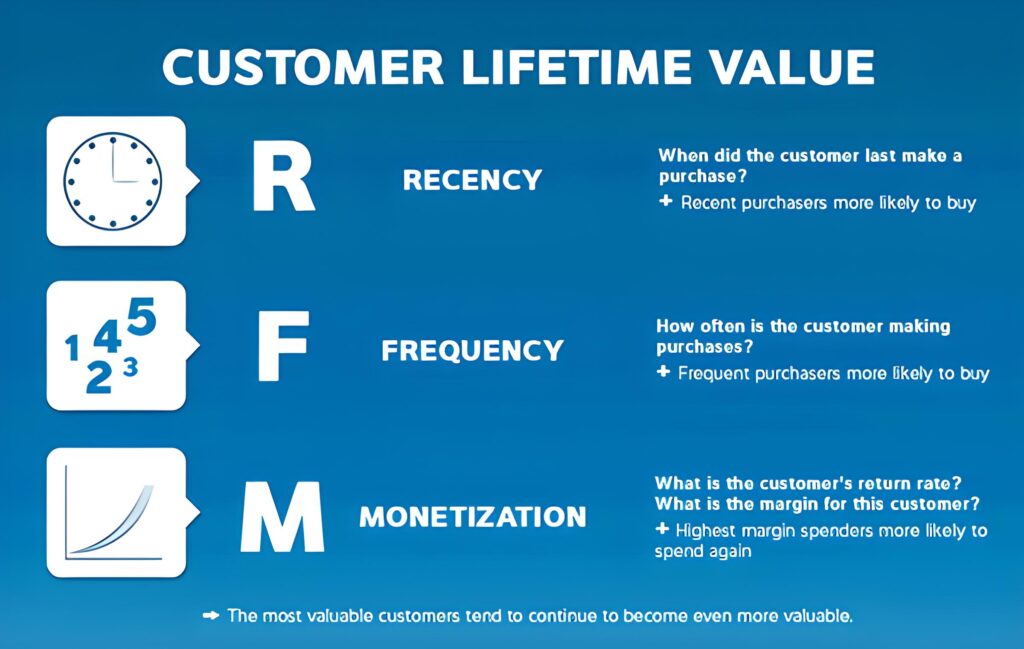
CLV is customer profitability that is estimated for the whole period that a customer will remain as a marketplace user.
There are two CLV elements that are influencing supply-demand balance:
- frequency of transactions;
- customer lifetime duration.
1.1 Frequency of transactions
The frequency of transactions reflects liquidity level over an eCommerce multi-seller platform.
Also, it helps to predict how many buyers you should acquire when having a certain number of sellers.
Usually, online multi-store marketplace sellers transact more often than buyers:
- Uber drivers have on average six transactions daily, while the customers transact once per eight days;
- an Airbnb host transacts every nine days, while guests transact once every two years on average;
- eBay sellers transact once a week; the ecommerce multi-seller marketplace buyers transact once a month.
However, there are ecommerce multi-seller mall concepts that imply a different transaction frequency ratio between suppliers and customers.
On Homehero, the multi vendor ecommerce store that provides caregivers, a supplier may be working with a single client for weeks. At the same time, one caregiver can work with three clients simultaneously over a time period, depending on a particular service a caregiver is giving to customers:

On Care.com, where you can find a babysitter, a supplier and a client can have just a single transaction over a few years, which can lead to a few years’ cooperation. In this case, transaction frequency is the same for supply and demand side.
Take into account those differences when deciding how many clients you need to bring on a virtual mall website over a given time period.
To balance suppliers and customers, Uber and Airbnb grow their buyers’ amount much more intensively than the seller base, while an ecommerce multi-seller platform like Care.com is supposed to be building supply and demand at the same speed.
Besides, consider the extent to which you can use one supplier’s time and if suppliers can process more transactions than they are currently processing.
While an eBay seller can easily extend transaction number, a babysitter can serve only one client at a time.
So, knowing your ecommerce multi-seller marketplace average transaction frequency, and the transaction amount that your ecommerce multi-seller mall sellers can process with no harm to quality, you can provide the optimum demand level for suppliers to be able to fulfill it without leaving customers unsatisfied.
Besides, knowing the highest transaction number an average seller can process, you can flawlessly define the moment when there are too many transactions for the current supply level and its time to acquire more sellers.
Transaction frequency is calculated as follows:
Transaction Frequency = Total Number of Transactions / Unique Customers
If you have 800 transactions and 500 unique customers for over a year, your annual transaction frequency number is:Annual transaction frequency: 800 / 500 = 1.6
Besides that, you can measure an average transaction length if it’s applicable to your online multi-store marketplace concept.
This will give you an additional lever to balance supply and demand.
Also, it can help to find the connection between transaction length and performance level, to further tweak the supply-demand balance.
Airbnb booking lengths of Superhosts and Regular Hosts
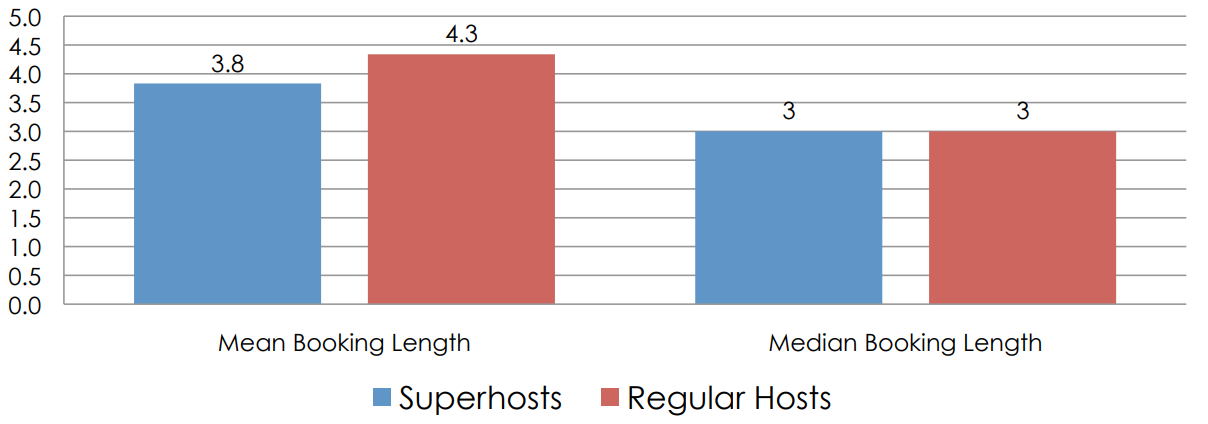
If your multi vendor ecommerce store embraces different types of transaction frequency, segment customers by the frequency of their transactions:
- high-frequency buyers;
- average frequency;
- low-frequency customers.
Using such segments, you can easily define the users that provide a higher transaction frequency and focus your acquisition efforts on them in order to increase liquidity on an ecommerce multi-seller platform.
Besides, if transaction frequency number is decreasing over a virtual mall website, it’s easier to find a reason to that by researching narrowed customer segments.

2. Customer lifetime duration
This CLV element reflects the average number of years, months, or days that a customer remains an eCommerce multi-seller marketplace user.
If your online multi-store marketplace customer lifetime duration is short, you need to acquire much more clients than sellers on a regular basis to cover this disbalance.
When customer lifetime duration is framed by just one transaction, you need to focus your efforts on customers’ acquisition, to keep the supply-demand balance.
On Opendoor, an ecommerce multi-seller mall where you can buy and sell a house, customers’ lifetime period is equal to one transaction — their house-selling process.
If your multi vendor ecommerce store customer average lifetime duration can be many years long, the strategy to balance supply and demand is different.
Once you acquired the number of customers that is optimal for your sellers to keep up with quality work, it’s necessary to focus on client retention.
Amazon customers’ lifetime often lasts for many years.
The ecommerce multi-seller marketplace Prime subscription offers loads of benefits for clients, and its aim is to retain clients on the ecommerce multi-seller platform over the whole lifetime period by keeping them satisfied.
The subscription works successfully: one out of every four homes uses it:
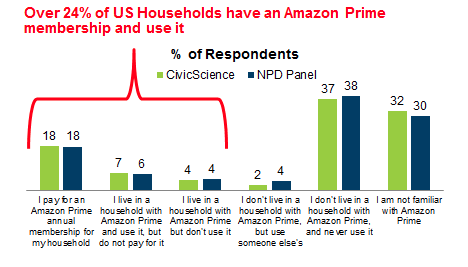
2.1 Customer churn
Customer churn rate shows how many clients your virtual mall website loses over a given time period.
It helps to define the average customer lifetime duration of your online multi-store marketplace.
Once you defined your ecommerce multi-seller mall average churn rate number and measuring it regularly, it helps to balance the demand and supply by making informed decisions on when and at which speed you should replace the users who go out of a ecommerce multi-seller platform on both sides.
Churn rate for a given period is calculated in two steps:
1. Customers’ number at the beginning of a period — Customers’ number at the end of a period = Number of churned customers
2. Number of churned customers / Total customers’ number X 100 = Churn rate
An example of churn rate calculation for one month period:
- a marketplace had 1,000 customers on the first day of the month;
- a marketplace had 950 customers on the last day of the month.
1. Customers’ number at the beginning of a period (1,000) — Customers’ number at the end of a period (950) = Number of churned customers (50)
2. Number of churned customers (50) / Total customers’ number (1000) X 100 = 5%
Churn rate for a period of one month is 5%
2.2 Retention rate
Retention rate, as opposite to churn rate, shows how many customers remain loyal to your multi vendor eCommerce store and are active users.
Uber US drivers’ retention rate over a year, percentage of active drivers
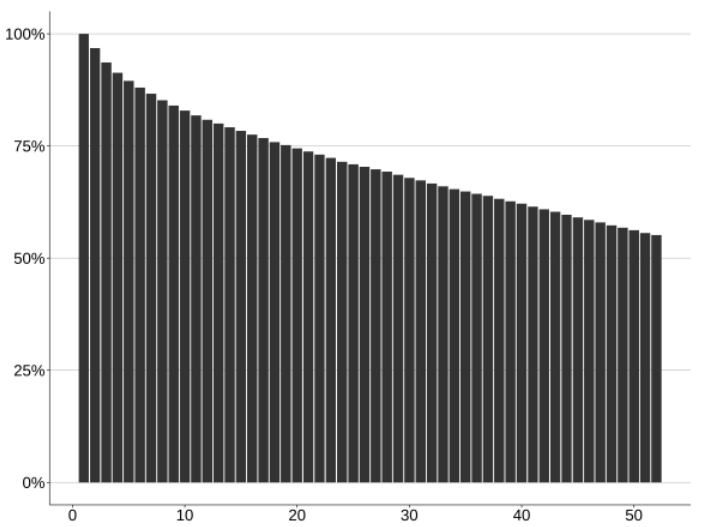
Just like churn rate, it helps not only to understand your average customer lifetime duration but to keep a finger on the pulse regarding your actual supply-demand balance.
Retention rate shows how actively you should be acquiring new customers to keep the optimal supply-demand balance of your virtual mall website.
It’s calculated by the following formula:
Retention rate for a given time period: (Number of customers at the end of the period — Number of new customers acquired during that period) / Number of customers at the start of the period) X 100
An example of retention rate calculation for one month period:
- at the beginning of the month: 200 customers;
- you lose 20 customers during the month;
- you gained 40 customers during the month;
- at the end of the month: 220 customers.
Retention rate for one month period: (Number of customers at the end of the period 220 — Number of new customers acquired during that period 40) / Number of customers at the start of the period 200) X 100 = 90%
Retention rate for one month period: 90%
Customer churn and retention rate are always added to 100%.
Thus, if a marketplace has a 90% retention rate, then its churn rate is 10%.
By using churn rate, customer lifetime duration can be calculated as 1/10% = 10 years.
Here is a table to convert retention rate and churn rate numbers in customer lifetime duration:
The table for converting Customer Retention Rate and Churn Rate into Customer lifetime period
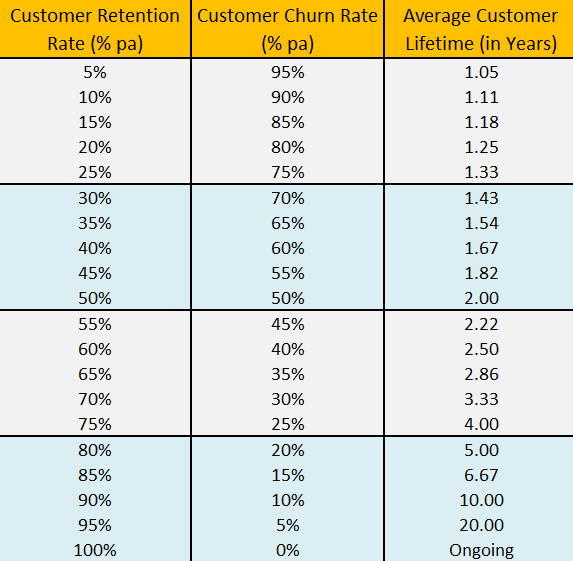
By increasing customer lifetime duration, you stabilize the supply-demand balance on your ecommerce multi-seller marketplace. The sellers and the ecommerce multi-seller platform in general, have an opportunity and time to build strong long-term relationships with customers.
To increase your customer lifetime duration, you should focus on the following:
- detailed understanding of your customer characteristics and needs;
- flawless user experience;
- an omnichannel approach to customer communication: define channels that work best for each user individually, and build communication through that unique set of channels—the most convenient for the client;
- high-quality customer service;
- the experience that happens after the conversion (delivery, support, and goods’ packaging).

3. Counting Customer Lifetime Value
To be able to apply Customer Lifetime Value to your supply-demand balancing strategy, use the following formulas to count your online multi-store marketplace CLV.
3.1 The simple and the main CLV formulas
A comprehensive guide about Customer Lifetime Value is offering two main formulas for CLV measuring, the simple and the complete one:
Two Customer Lifetime Value formulas
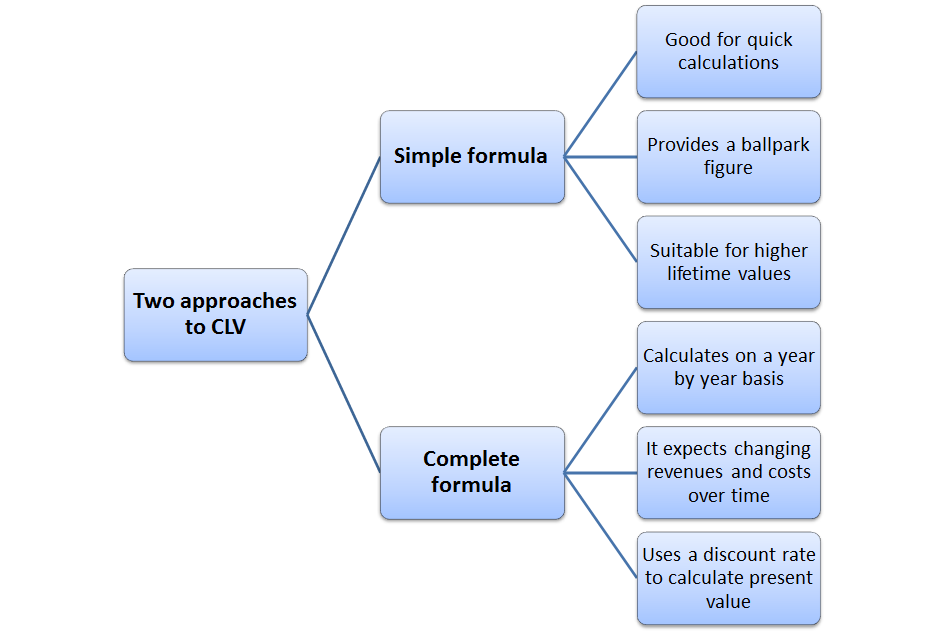
The simple formula should be used if client revenues and acquisition costs are constant over the total customer lifetime, and customer’s annual profit is flat.
It’s a CLV calculation with a net profit.
It is calculated as follows:
Annual net profit contribution per customer X Average number of years that they remain a customer — Customer acquisition cost
An example of CLV calculation using the simple formula:
- annual profit from the customer = $1,000;
- number of years as a customer = 5 years;
- customer acquisition cost = $2,000.
CLV in this case would be: $1,000 X 5 — $2,000 = $3,000
The main formula
This formula is useful if your ecommerce multi-seller mall customers’ revenues and retention rates are changing yearly.
It’s calculated as follows:
Annual profit contribution per customer (for each year under consideration) XThe total customer retention rate — Acquisition cost
An example of CLV calculation using the formula:net profit in year one = $1,000;net profit, which increases to $1,500 in year two;
net profit which increases to $2,000 in year three;the retention rate = 75%;
acquisition cost = $500.
Year 0 = — $ 1,000 acquisition cost;Year 1 = $1,000 customer profit;Year 2 = $1,500 customer profit X 75% retention = $1,125Year 3 = $2,000 customer profit X 56% (75% of 75%) retention = $1,120;
Also, the formula allows the adjustment of each yearly figure by an appropriate discount rate.
An example of CLV calculation with discount rate is here.
3.2 CLV counting on the basis of Customer Value
Customer Value differs from Customer Lifetime Value (CLV): all calculations are made for a defined timeframe, not for a whole customer lifetime.
It can be used in case if CLV measuring is based on historical data of purchasing.
Customer Value = Average Order Value X Purchase Frequency
It is a simple way to calculate CLV:
CLV = Customer Value X Customer Average Lifespan
Besides CLV calculation formulas, here is an online CLV calculator to measure it quickly, and a couple of thorough CLV guidelines to build a CLV counting approach that fits your multi vendor ecommerce store concept completely.
Customer Lifetime Value varies significantly over different categories of goods:
CLV among different product types
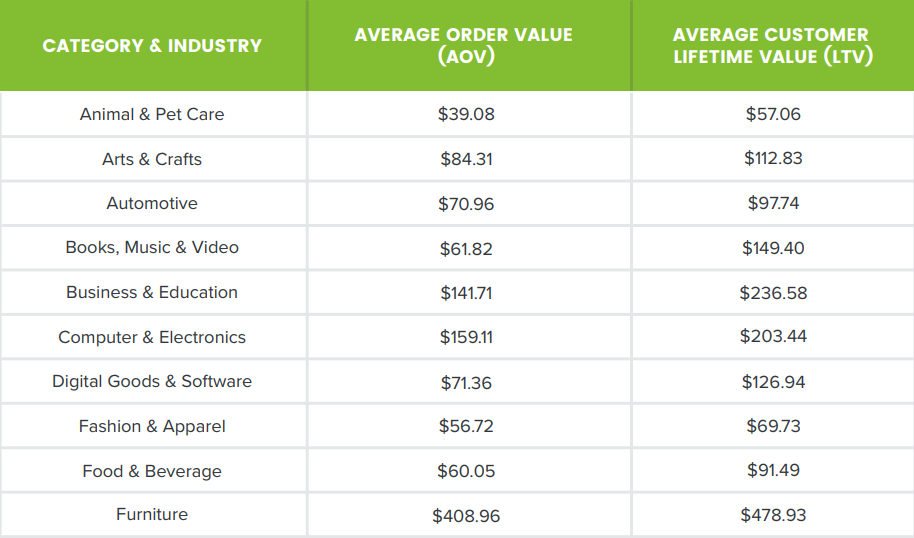

True Experience #1

Monica Eaton-Cardone, the co-founder and COO of Chargebacks911
This risk mitigation firm manages more than 2 billion transactions annually to help online merchants optimize profitability through chargeback management. Chargebacks911 is headquartered in the Tampa Bay area, with offices in North America and Europe.

Calculating your customers’ lifetime value is important. The amount you spend to acquire a customer should never outstrip the amount that customer is worth to the business. It’s shocking that this basic principle is so simple…yet so often overlooked. There should be a margin of profit when you stack the total amount spent by each customer against the resources and time you direct at them in the sales stage. Otherwise, it’s simply not worth the investment.
The problem is that optimistic merchants often overcalculate the lifetime value of a customer. Many, especially those with new, fledgling operations, make the mistake of investing heavily to acquire customers early-on. They expect this approach will help products go viral, but there is no guarantee of success.
The name of the game is to minimize your advertising costs and overhead by creating a systematized method that is applicable to a range of customers. This approach can decrease your cost of customer acquisition and increase average customer LTV. Start by thinking up every question that an average customer will have about your product. Ask yourself: “What is the value proposition? What sets it apart from competitors?” Condense this down into a scalable formula that can cover as much ground as possible. Remember: this is a life-or-death calculation. You need to monitor LTV closely and adjust as necessary if you want to stay in business.
True Experience #2

Tim Absalikov, co-founder, and CEO of Lasting Trend – Digital Marketing Agency in New York

It is immensely important to determine your customers’ lifetime value or CLV for short. Understanding your CLV allows you to see the total amount of money that a particular customer is likely to spend over his or her lifetime. This metric gives you a baseline to measure advertising performance, helps determine business worth, it can act as a benchmark for future growth and expansion and etc.
Well, the biggest effect will be an increase in revenue. When you go to increase your CLV, the best way to do it is to create personalized promotions for each or a group of similar customers. While doing all of that, you will also see that customer loyalty grows as well. What customer wouldn’t be loyal to a brand that was loyal and good to them?
Since sellers usually transact more frequently it’s best to onboard sellers early on and fast. Their repeat business can be crucial in the early stages of growth.
Tweak your CLV calculation to your ecommerce multi-seller marketplace product type and concept meticulously.
It will help you identify transaction frequency and customer lifetime duration accurately, and create a stable supply-demand balance on a long term.
It’s best to count estimated CLV and understand your multi vendor ecommerce store future transaction frequency and customer lifetime duration on a concept planning stage already.
In this way, you’ll able to define all the potential issues that you might encounter while balancing supply and demand and create a strategy to overcome them aforehand.

Yan Anderson is the Head of Content Marketing at CS-Cart with over 10 years of experience in the eCommerce industry. He's passionate about explaining complicated things in simple terms. Yan has expertise in building, running and growing eCommerce marketplaces. He loves to educate people about best practices, new technologies, and trends in the global eCommerce industry.

